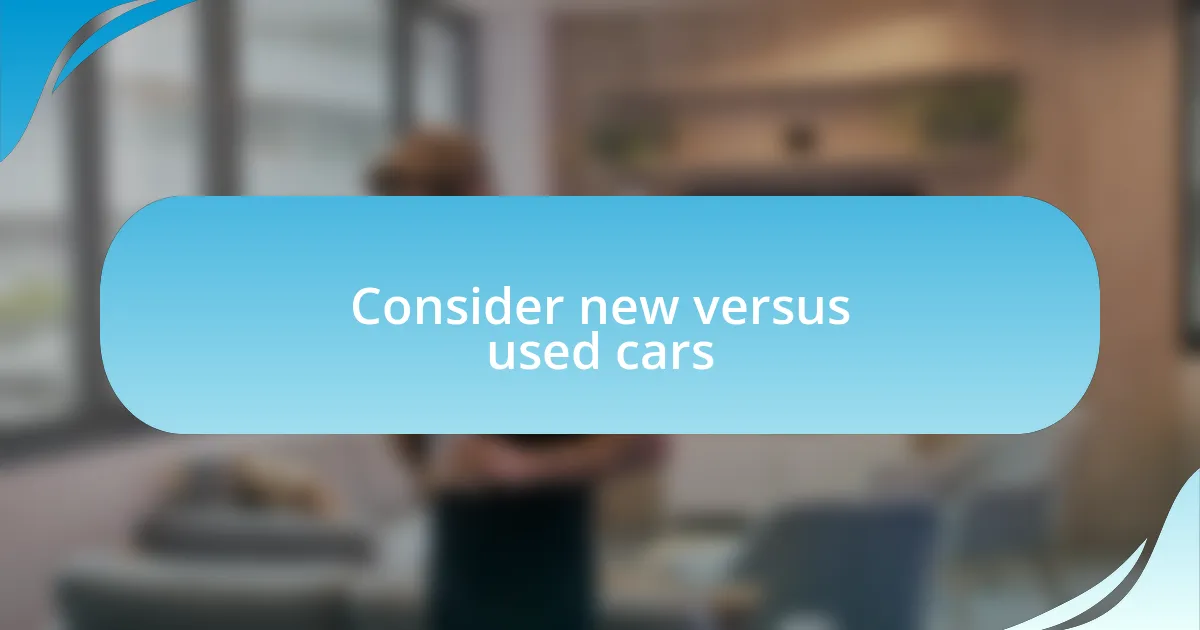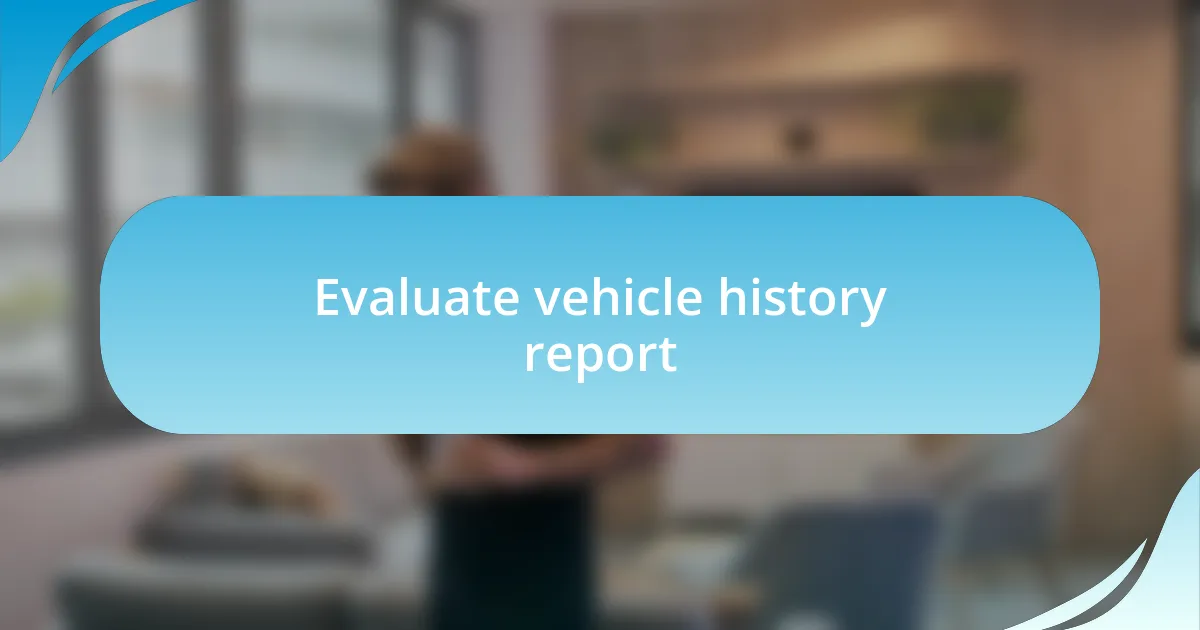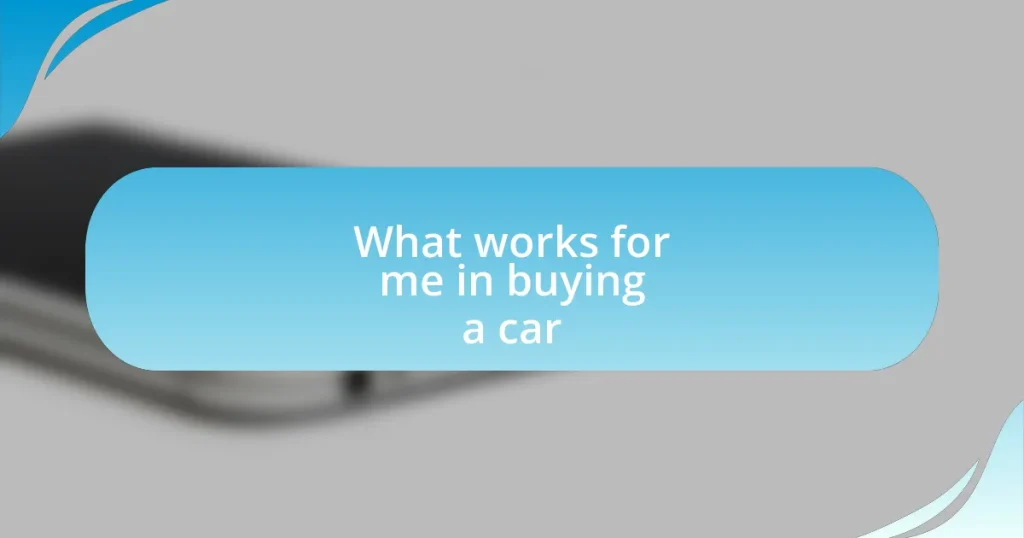Key takeaways:
- Identifying your budget is crucial; consider all costs like insurance and maintenance beyond just the purchase price.
- Thoroughly research car models for reliability, fuel efficiency, safety features, and resale value to find the best fit.
- Evaluate financing options and check your credit score to secure favorable interest rates, which can significantly affect overall costs.
- A vehicle history report and detailed inspection before purchase help avoid future financial burdens from hidden problems.

Identify your budget
When I first set out to buy a car, I quickly learned that identifying my budget was essential. It’s more than just the sticker price; you have to think about insurance, maintenance, and fuel costs. Have you ever felt that rush when you see a car you love, only to realize later that it’s out of your financial reach?
I remember pinching pennies to save up for my first car, balancing between my expenses and my dream vehicle. I made a list of what I could afford without stretching my finances too thin. Trust me, avoiding that sinking feeling of buyer’s remorse is worth the effort of figuring out a solid budget from the get-go.
Once you’ve established your financial capacity, don’t just stick to it blindly. Flexibility can help if you find that perfect car that’s slightly above your initial budget. I often wonder how many people settle for less because they don’t consider their options realistically. Budgeting should empower you, not limit you.

Research car models
Researching car models is one of the most exciting parts of the car-buying process. It’s like embarking on a treasure hunt, trying to discover the perfect fit for your needs and lifestyle. I still remember spending hours scouring the internet, watching videos, and reading reviews about various models before settling on a few that caught my eye. This phase is crucial because it helps you determine what features are most important to you and what fits within your budget.
To make the most of your research, consider these factors:
- Reliability: Look for models with strong reliability ratings to avoid unexpected repair costs down the road.
- Fuel Efficiency: Determine your daily driving habits and find models that will save you at the pump.
- Safety Features: Research the available safety features—some models offer advanced technology that can significantly enhance safety.
- Resale Value: Investigate the car’s resale value to ensure it’s a sound investment in the long run.
I learned the hard way that not every car lives up to its reputation. I was drawn to a sporty coupe only to discover that it lacked practicality for my commuting needs. This experience reminded me that thorough research goes beyond just the features; it’s essential to consider how the car fits your daily life.

Consider new versus used cars
Considering whether to buy a new car or a used one can feel overwhelming, but I’ve found it essential to weigh the pros and cons of each option carefully. New cars generally come with the latest technology, warranty coverage, and often better fuel efficiency. However, they depreciate quickly—sometimes losing thousands in value in just the first year. In my experience, I once splurged on a brand-new model, and although it was exhilarating, the sharp decline in value really hit home when I considered how much a similar used car would have saved me.
On the flip side, purchasing a used car can provide significant cost savings and offer great value if you choose wisely. Many used models are still in excellent condition and come loaded with features that you might pay extra for in a new car. When I bought a pre-owned SUV a couple of years back, I was pleasantly surprised by how much more I could afford, allowing me to invest in better insurance and maintenance plans.
Ultimately, my approach has been to assess what I truly need. Do I want the thrill of that new car smell, or am I more interested in minimizing my expenses? This personal reflection has consistently guided my decision-making.
| Factor | New Cars | Used Cars |
|---|---|---|
| Cost | Higher purchase price | Lower purchase price |
| Depreciation | Rapid depreciation in the first few years | Slower depreciation |
| Warranty | Typically includes a full warranty | May have limited or no warranty |
| Availability | Latest models and features | Vast selection of models, often with great features |
| Financing Options | More favorable financing terms | May have higher interest rates |

Understand financing options
Understanding financing options is crucial in the car-buying process, and it can truly make or break your experience. When I financed my first car, I opted for a loan with a low-interest rate, and it felt like I’d struck gold. It’s amazing how finding the right financing can ease financial stress and make ownership enjoyable rather than burdensome.
There are various financing avenues to explore, such as loans from banks or credit unions and dealership financing. When I walked into a dealership, I was surprised by how often manufacturers offered promotional rates that ranged from 0% to 3%. I still remember the exhilaration of snagging a sweet deal—it’s like finding a diamond in the rough, and that feeling alone made the entire process worthwhile.
Have you ever considered how your credit score impacts your financing options? I hadn’t until I saw the difference it made in my interest rates. A few percentage points might seem small, but they can add up to significant savings over time. It really hit me how important it is to check your credit history before diving into the financing world; it’s a step that can save you both money and heartache later on.

Evaluate vehicle history report
Evaluating a vehicle history report is one of the most crucial steps in the car-buying journey. When I first stumbled upon a seemingly ideal used car, I learned quickly how vital this report could be. It revealed past accidents I wasn’t aware of, and suddenly, the car that looked pristine turned into a cautionary tale.
A vehicle history report provides a detailed account of the car’s life, including ownership records, mileage discrepancies, and any reported accidents. I remember when I checked the report for a car I was interested in; it showcased a clean slate, and I felt an immense sense of relief. The peace of mind that comes from knowing a car’s background is invaluable—it’s like having an invisible safety net beneath your purchase.
Have you ever purchased a car without fully investigating its past? I did once, and it was a major lesson learned. The subsequent repairs were a financial burden that could have easily been avoided with a simple history check. Trust me, investing a little time in this report can save you from future headaches and expensive surprises on the road.

Test drive and inspect vehicles
When it comes to test driving a vehicle, I find it’s where the rubber truly meets the road—quite literally! On my last car hunt, I remember the exhilaration of getting behind the wheel. I took a moment to settle in, fiddled with the controls, and then hit the open road. That first acceleration—a crisp, responsive thrill—told me so much about the car’s potential. Have you ever felt the difference between a car that feels comfortable and one that feels like a chore? For me, it’s all about that initial connection.
Inspecting a vehicle is equally essential. I can’t stress enough the importance of thoroughly checking everything from the paint job to the tires before driving off. Once, I overlooked a small scratch thinking it was insignificant, but during my inspection, I discovered it was masking deeper damage beneath the surface. I learned that the way a car presents can often hide bigger issues, and that small oversight could have turned into a costly repair down the road. So, I always advise looking closely—almost like you’re a detective on a mission.
After the test drive, I’ve found it helpful to take a moment to reflect. How did the car feel overall? Was the ride smooth or bumpy? I remember sitting in the car after a long test drive, just to gather my thoughts and weigh my emotions against the car’s performance. It’s a little ritual I have now—taking that time can often clarify whether or not I’m ready to commit to a purchase. Have you had a moment like that in your own car-buying experience? Trust your instincts; they often speak louder than the specs listed on the dealership brochure.

Negotiate the final price
Negotiating the final price can feel like a dance, and I’ve learned that preparation is key. During one of my car-buying adventures, I did my homework, researching similar models’ prices. When I went to the dealership, I felt empowered presenting this data. Have you ever seen a dealer’s expression shift when you come in armed with facts? It’s a game-changer.
I’ve experienced the mindset shift needed during negotiation. Initially, I felt anxious about haggling, but I realized that it’s just a conversation about value. I remember one instance when the dealer suggested a price that was far above my budget. Instead of feeling defeated, I calmly shared my offers and backed them with my research. The negotiation turned into a collaborative effort rather than an adversarial one. This approach not only helped me feel more confident but also led to a price I was happy with.
Establishing rapport with the salesperson can yield surprising results, too. I’ve found that sharing a bit about my car history helps create a connection. The last time I bought a vehicle, I mentioned my appreciation for reliable cars, which prompted the salesperson to open up about their experiences as well. Suddenly, we weren’t just discussing cars anymore—we were sharing stories. And in that exchange, the dialogue shifted, leading to a more favorable price for me. Have you considered how personal connections could tip the scales in your favor? It makes the process less transactional and more about mutual understanding.













